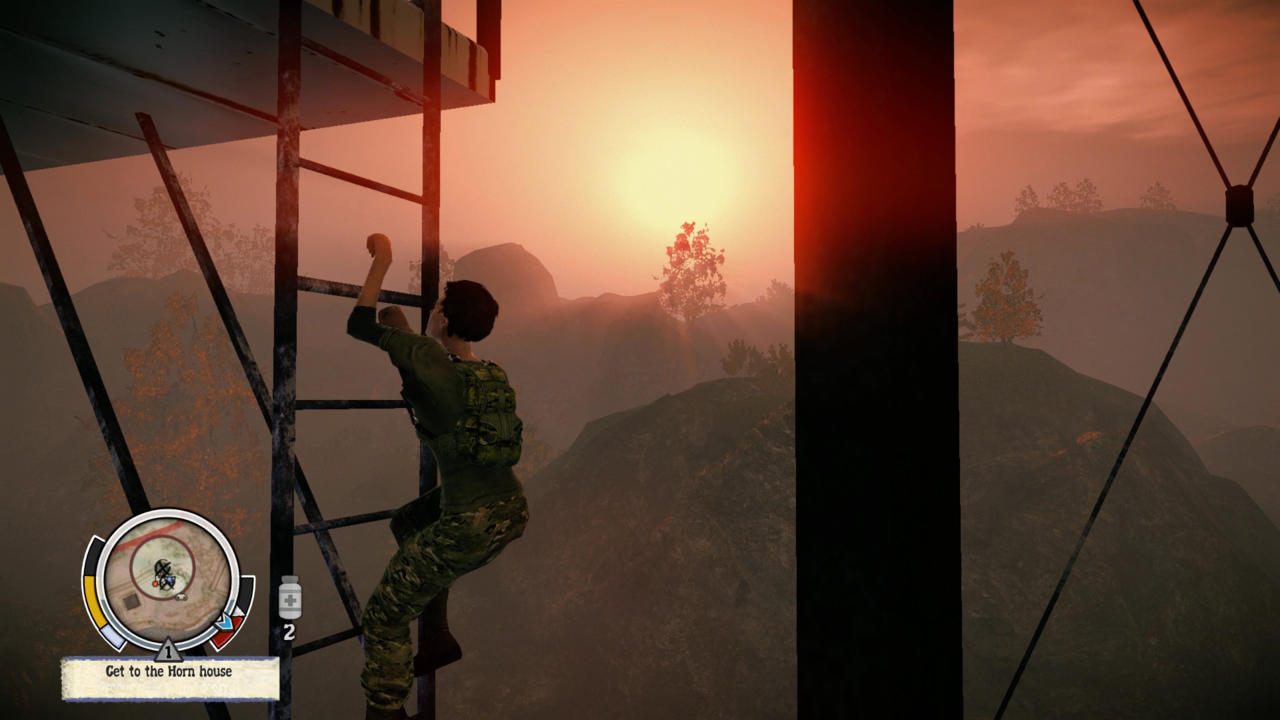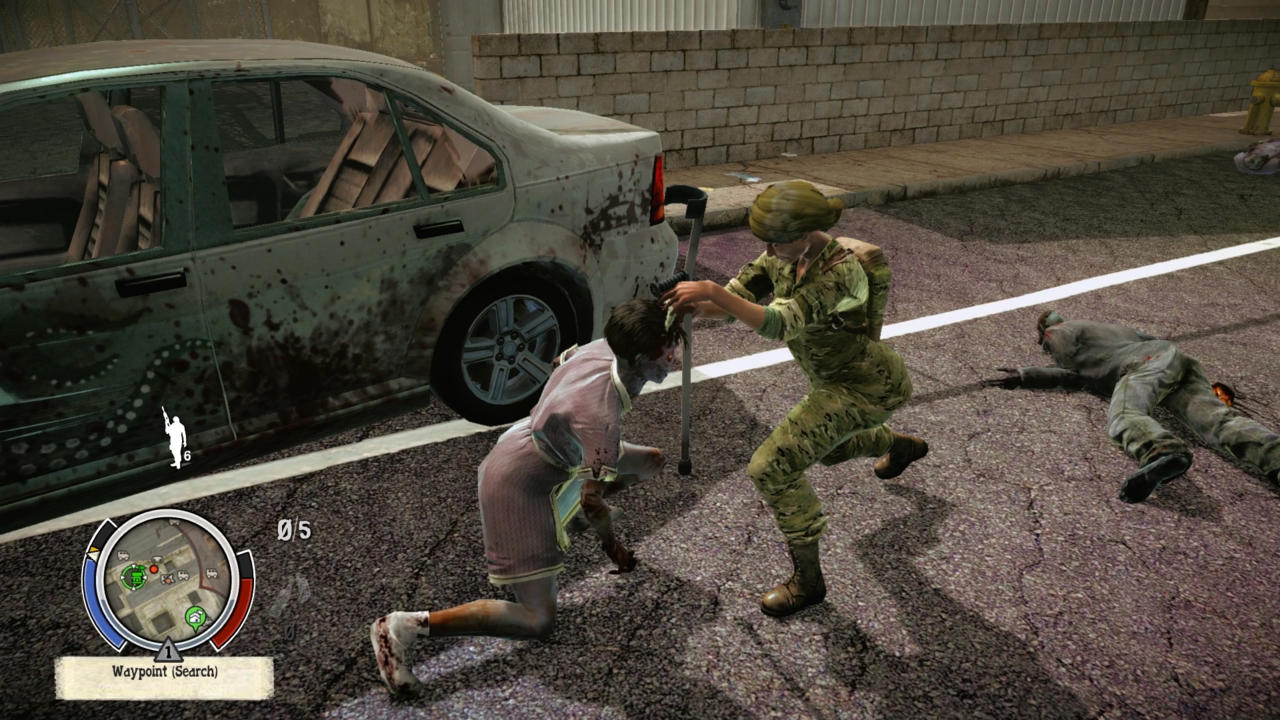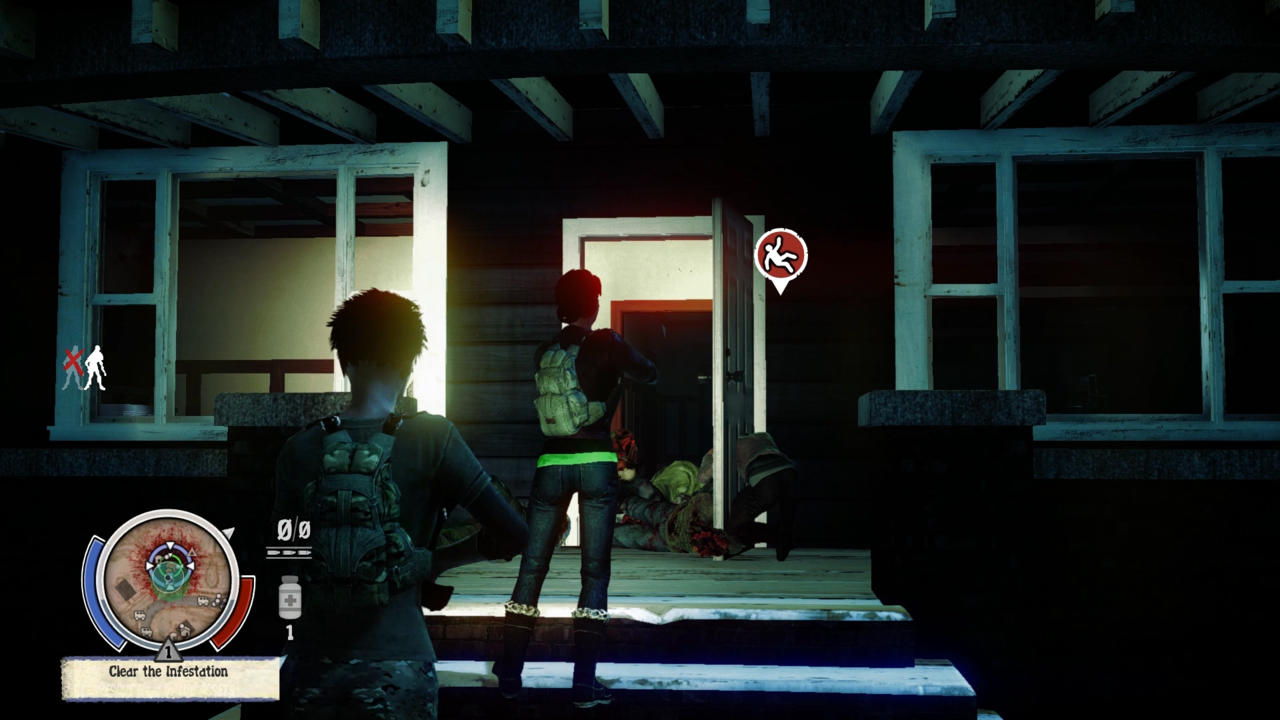State of Decay Year One Edition Review Gamespot
The Johnson County zombie war.
He agreed that it was time. He was infected. Information technology was more than the Zed curse. Nosotros all had that--nosotros knew that we were ticking zombie fourth dimension bombs. He was sick, and he was going to die, but he couldn't practise it at our new home. We couldn't risk it; nosotros'd sacrificed and then much to get there. We drove to a dwelling house in what had been the pristine town of Marshall. How many suburban daydreams had died since the outbreak? He could dice with nobility here. Only when we arrived at the home, he fled. I chased him in his aimless sprint across the decaying just once vibrant Trumbull Valley--killing hordes of zombies to protect him--until, 20 minutes later, I realized that I'd encountered some other of State of Decay's game-breaking bugs, and I had to reload my save and start anew.
Whenever I endeavour to describe Land of Decay to people who have never played the game, I find myself describing the game I want State of Decay to exist--and the game that Undead Labs attempted to craft--more than than the game that Land of Disuse actually is. Country of Disuse wants to be many games--main amidst them the kickoff video game to properly capture the community survival elements of a Dawn of the Dead flick in mechanical terms (as opposed to the narrative terms of Telltale'southward The Walking Dead)--and, at its all-time moments, information technology creates a sense of customs, tension, and graphic symbol agency matched past few of its peers. But for each moment of spontaneous, unscripted story wonder that State of Decay generates, it is as well one glitch, bug, or broken feature away from drawing you completely out of its experience.

Intelligent play is not nearly equally interesting equally life on the edge of total annihilation.
State of Decay: Year-One Survival Edition collects the base Country of Decay game from 2013 too as its 2 major add together-ons (the space sandbox Breakdown and the story-driven Lifeline), and updates it for the Xbox Ane and PC (for those who didn't already own the game for the latter). Set in an unspecified portion of the United states of america, Country of Decay tasks you with ensuring the survival of an always-growing (or shrinking, depending on your competency of play) community after a zombie apocalypse consumes the world. Yous assemble resources, explore, and fight (but mostly avoid) the undead equally you look to stay alive.
State of Decay feels similar a collection of other games' remnants in part considering its diverse systems are split and distinct entities that often fail to complement each other in meaningful ways. Though the initial hours of the game may give the impression that State of Disuse is a punishing and clunky exploration-focused activeness-adventure game as you complete the scripted prologue and the early (but still heavily scripted) hours of more than freeform play, its principal focus is on building and maintaining your community of survivors.
Beyond a handful of plot-mandated characters--who tin all meet permanent expiry if you fall to ane of the game'southward many ways to die--you collect a procedurally generated group of survivors that you lot both command directly and observe as they integrate into their new dwelling. Whether information technology'due south the cramped confines of the Spencer's Mill church, where the game proper begins, or one of the more than spacious shelters that you can find throughout State of Decay's massive world, you employ these survivors to explore towns and the wilderness to wait for supplies--nutrient, bullets, guns, medicine, construction materials--to ensure the survival of your home besides as to consummate the missions that rocket State of Decay toward its (literal) explosive stop.

Yous may come to rely heavily on the kickoff 2 characters you observe in State of Decay--the tough but lovable Marcus and the guarded simply bad-ass Maya--just information technology's the procedurally generated characters and their interactions with the established voices in your grouping that craft many of the game's well-nigh interesting stories and help to provide a distinct sense of personality to each playthrough. Eventually, however, the core gameplay loop starts to experience monotonous and tired, which sets in the second your shelters begin to develop any sense of consistent security and prosperity.
One of my procedurally generated heroines joined the group and didn't desire to become to know or talk to anyone across Marcus, who had rescued her from a horde when she'd gone out on one of her first supply runs. Only, when I played her on a sprint (once once more literal, as I'd accidentally encounter another horde) focused just on acquiring food and construction materials from nearby buildings in Marshall, our resident "voice on the radio"--the lupus-infected Lily--called me and asked if I'd pick upward a keepsake from her deceased father. My heroine had no reason to aid Lily, but I did it--and nearly died--and finally, this girl who had felt similar a collection of statistics began to feel like she belonged in the grouping. And, from then on, she became an integral part of my grapheme rotation.
Your play is every bit much defined by who dies as it is by who lives and contributes the nigh to the success of your group. Beyond ii members of my party who died of a story-mandated plague, I but lost ane other member of my State of Decay family. I'd sent one of my original survivors from the church building out to run across with the Wilkersons--a family of gun-running thugs whom I decided to placate rather than confront--but she never made it that far. On her drive to their farmhouse, I noticed a supply drib in a huge corn field and investigated. I should have known better. I'd nearly died opening one earlier in the game. The supply drop was a hotbed of zombie activity, and before I could run back to my truck, a Feral--the about aggravatingly agile and swift type of zombie--grabbed her, and, by the time I had pushed him away, a sea of zombies had her surrounded on all sides. She was ripped into gory halves.
Land of Decay is always one glitch, bug, or cleaved characteristic away from drawing you lot completely out of its experience.

The endgame supports a solid strategy of turtling and edifice up defenses, meaning that you rarely feel the sting of encroaching starvation or the fear that your ammo supply has run dry. Otherwise, State of Disuse'south choices and consequences are simply tangentially related to the main plot. Every resource you use is gone forever and a choice y'all won't have once again down the route, and State of Decay never lets y'all forget it. The fear that a beloved and effective melee weapon will suddenly break is always there. If you play well plenty to atomic number 82 your survivors to a caste of condolement and security, you feel that you earned it through judicious planning and execution, although y'all miss those sweat-inducing early on runs in the game where failure and retreat meant that some survivors wouldn't eat that day. It all becomes too routine if you play well enough; Intelligent play is not nearly as interesting equally life on the edge of total annihilation.
By the endgame, you accept enough resources to not have to worry virtually the supply runs that are the central to success in the early on game, beyond finding relatively mutual construction materials, which remain central throughout the game. You are too provided enough human capital to eliminate most of the challenge of avoiding the great masses of zombies that the game intentionally designed to kill you lot swiftly if you appoint too many at in one case. "Influence" is the game's primal currency, which you proceeds for completing missions and runs, and y'all can use it to ask other members of your community for help--a good design and essential for clearing out packed infestations--equally well as to call for fill-in from survivors in Trumbull Valley who aren't office of your group. This is problematic when you can call in three magical SWAT squad members for a barely nominal influence fee who can and then shotgun-smash all the zombies swarming that hard-to-accomplish supply drop. The cooldowns on those abilities keep you from spamming them, but if you save them for major missions, they remove every terminal ounce of claiming from the game.
Despite that, the graphic symbol-generated stories in State of Decay--leaving Spencer's Factory for fright of the war machine only to go close allies with them in a well-planned twist and realizing the final cost of my appeasement of the Wilkersons--are so fascinating and well crafted that the game's failures in near every other category become all the more than disturbing. Year-One Survival Edition has addressed few, if any, of the bugs, glitches, and basic structural flaws at the heart of the base game. Environmental clipping is constant throughout the game. Zombies often wander halfway through walls and doors. Textures don't so much pop in as entire structures and characters appear out of nowhere, including one instance where I killed an invisible zombie that was terrorizing my grouping. The AI of your fellow survivors ranges from "at least they aren't getting themselves killed" to "where the hell are they going, and why won't they stop?"

The graphic symbol-generated stories are and so fascinating and well crafted that the game'due south failures in virtually every other category become all the more agonizing.
It isn't quite right to say that the cars in the game control like boats. At least boats in the h2o have some degree of mobility and precision. The cars in State of Disuse control like boats on country. The game intentionally makes melee combat against more than 2 or three zombies at in one case difficult both to sell how vulnerable your graphic symbol is and to teach yous to avoid being swarmed, just combat in any sense in Country of Disuse also reminds you that your character barely controls better than your vehicles, and information technology'southward besides like shooting fish in a barrel to get defenseless in the environs or behind AI characters that don't know how to get out of the mode and then observe a valuable member of your party killed for good. As for inventory management, I appreciate the notion that there'due south only so much stuff a person can carry at once, but the lack of an power to give your squadmates equipment and items, and the carte du jour-heavy nature of organizing your supplies, constantly draws y'all out of suffocating survivalist atmosphere and reminds you that you lot're playing a game.
Trumbull Valley itself never feels like a place that would really exist. It comes off as a bizarre hybrid of the American Southwest with its rocky orange protuberances dotting the landscape fused with World of Warcraft'due south Westfall, with tiny farmsteads and towns propped up with cornfields elsewhere. State of Decay's full lack of aesthetic cohesion is never charming in an ironically intentional sense; instead, information technology constantly reminds you that you're playing a game that could be so much better.
If I found myself describing the game to friends equally the game I wanted it to be more than the game it was, it's because the "ideal" version of State of Decay is exhilarant. When State of Decay was fashioning stories around my coiffure and the decisions I made--or failed to make by taking too much fourth dimension to act and costing the lives of people not in my direct group--it spoke to a world that existed both around the choices I fabricated and beyond annihilation my individual play shaped. But Land of Decay was too willing time and time again to remind me non just of its inherent gaminess, but also that big swaths of that game were outright broken.
Back To Height
Source: https://www.gamespot.com/reviews/state-of-decay-year-one-survival-edition-review/1900-6416116/
0 Response to "State of Decay Year One Edition Review Gamespot"
إرسال تعليق